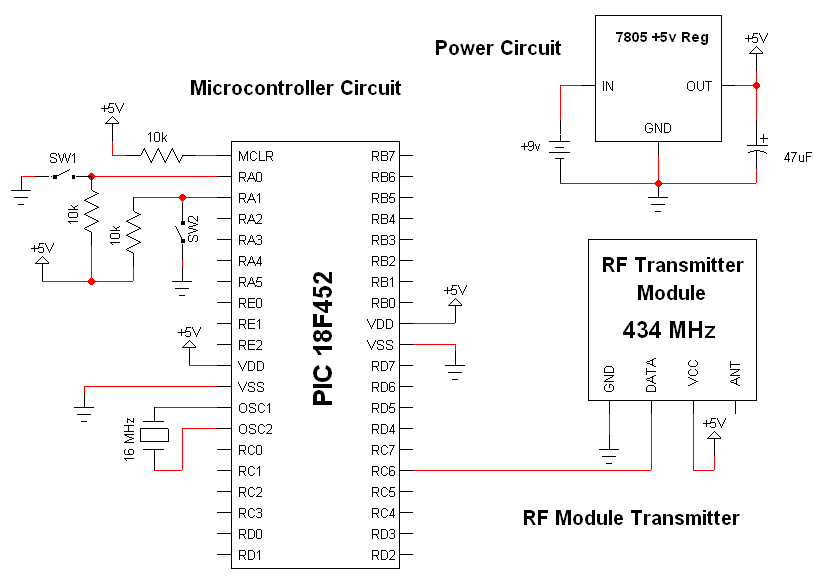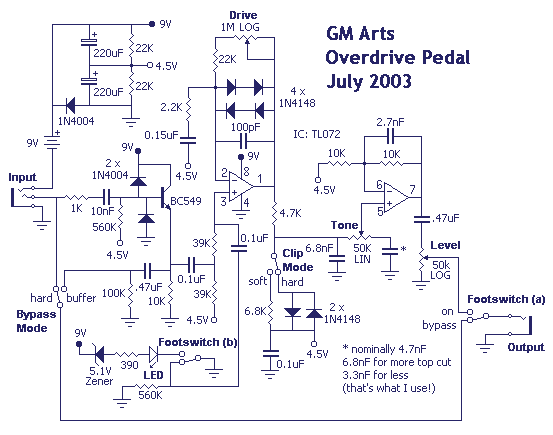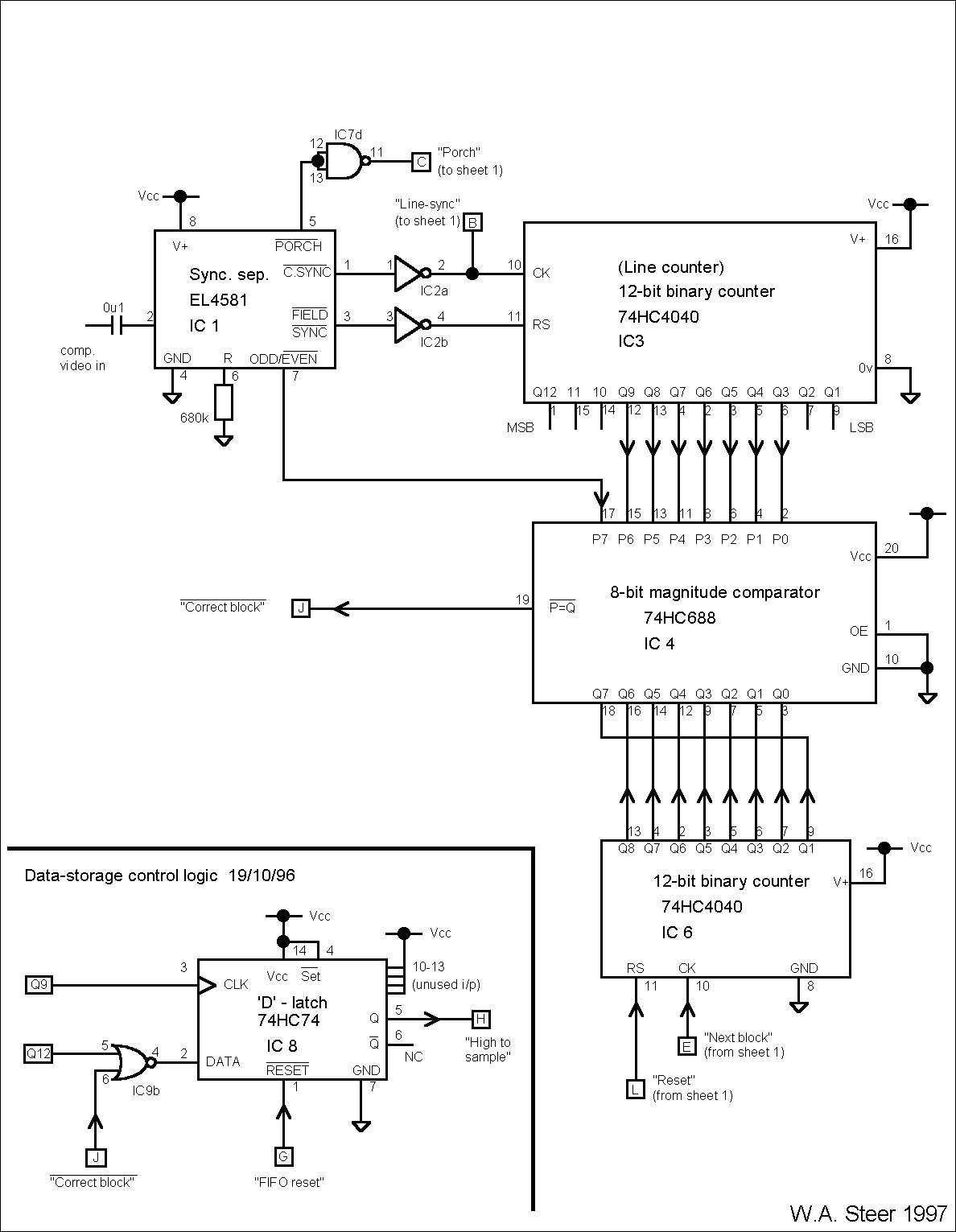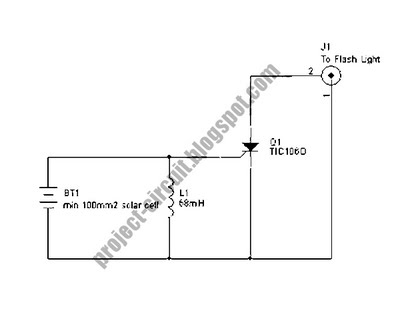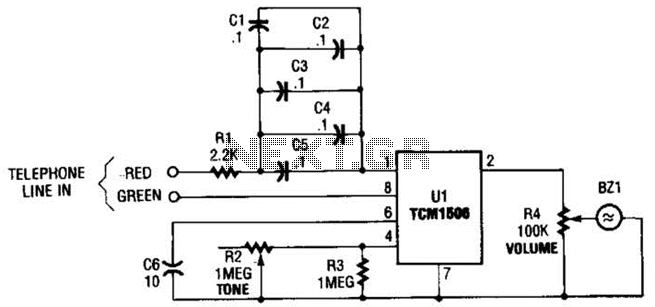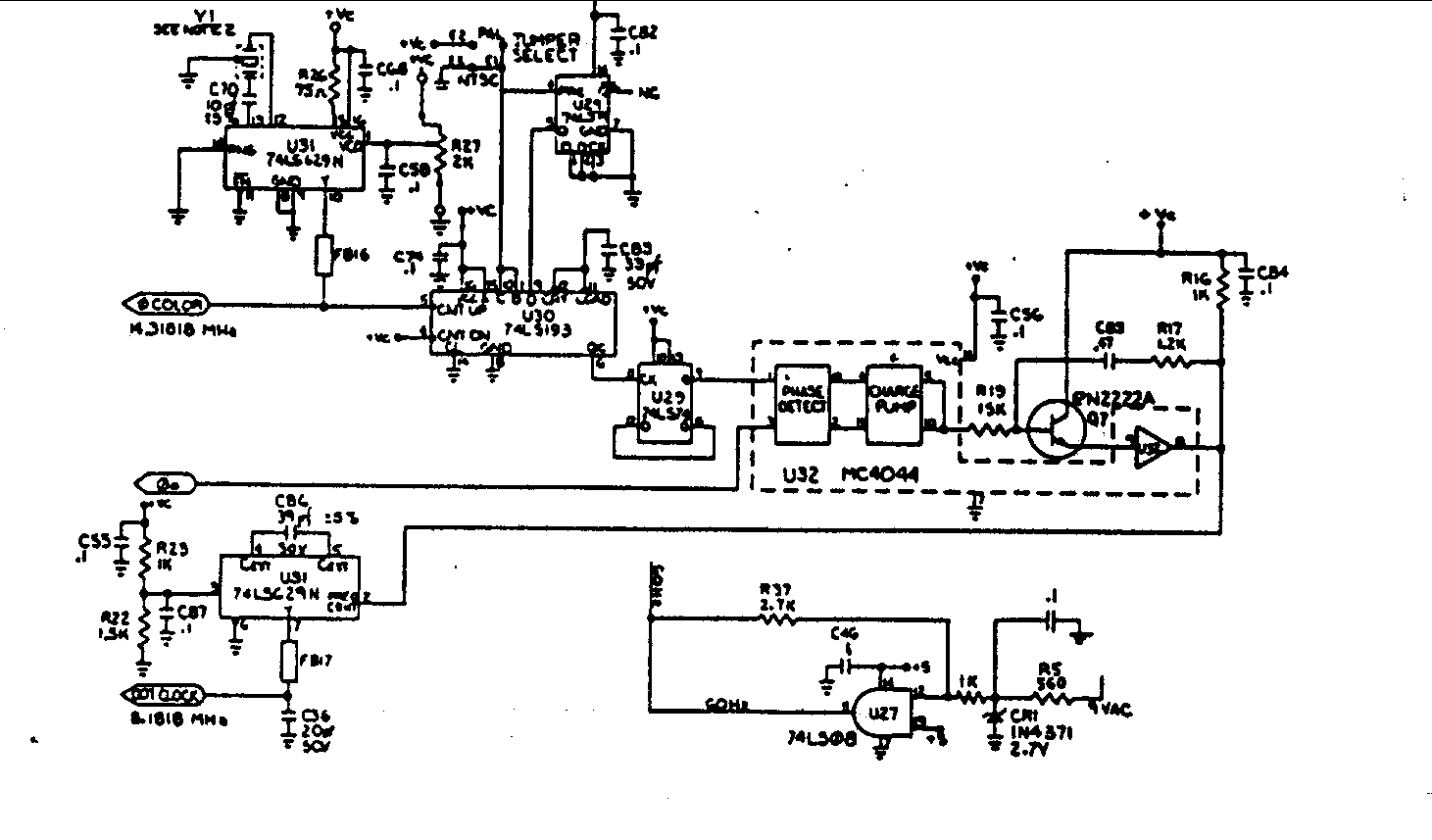
MOSFET IRF510 Capacitor Discharge Ignition(CDI) Circuit and explanation
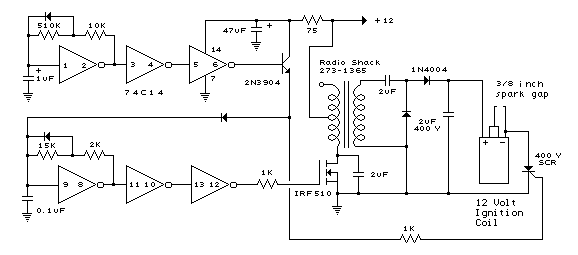
A 2 µF capacitor is charged to approximately 340 volts, and the discharge is controlled by a silicon-controlled rectifier (SCR). A Schmitt trigger oscillator (74C14) and a MOSFET (IRF510) are utilized to drive the low-voltage side of a small (120/12 volt) power transformer, while a voltage doubler arrangement is implemented on the high-voltage side to elevate the capacitor voltage to around 340 volts. An analogous Schmitt trigger oscillator is employed to trigger the SCR at a frequency of approximately four times per second. The power supply is disabled during the discharge period to allow the SCR to stop conducting and return to its blocking state. A diode connected from the 3904 transistor to pin nine of the 74C14 prevents the power supply oscillator from operating during the discharge phase. The circuit draws only about 200 milliamps from a 12-volt supply and delivers nearly twice the conventional energy output of a standard ignition circuit. The high voltage from the coil reaches approximately 10 kV, utilizing a 3/8 inch spark gap at standard air temperature and pressure. The spark rate can be increased to potentially ten Hertz without significant loss of spark intensity; however, it is limited by the low-frequency transformer and the duty cycle of the oscillator. For higher spark rates, a higher frequency and lower impedance supply would be necessary. It is important to note that the ignition coil is not grounded, presenting a shock hazard at all terminals. Caution is advised when operating the circuit. An alternative method for connecting the coil involves grounding the negative terminal and relocating the capacitor between the cathode of the rectifier diode and the positive terminal of the coil. The SCR is then positioned between ground and the +340 volt side of the capacitor, which reduces the shock hazard and is the typical configuration used in automotive applications.
The described circuit functions primarily as a high-voltage ignition system, combining several key components to achieve efficient energy transfer and high-voltage output. The 2 µF capacitor serves as the energy storage element, charged to a high voltage to enable significant discharge. The SCR acts as a switch, allowing controlled release of the stored energy, while the Schmitt trigger oscillator generates the necessary control signals for the SCR and the MOSFET.
The 74C14 Schmitt trigger oscillator is designed to provide a stable square wave output, which is essential for driving the MOSFET, IRF510. The MOSFET operates as a low-voltage switch, controlling the power transformer that steps down the voltage from 120V AC to a lower level, suitable for the oscillator circuit. The voltage doubler circuit on the high-voltage side ensures that the voltage across the capacitor is maintained at the desired level, facilitating the ignition process.
During operation, the SCR is triggered by the Schmitt trigger oscillator at a frequency of four times per second, allowing for controlled discharges of the capacitor. The diode connected to the 3904 transistor plays a crucial role in ensuring that the power supply is disabled during the discharge phase, preventing accidental triggering of the SCR. The system is designed to operate efficiently, drawing minimal current from the power supply while delivering high voltage output.
The ignition coil's output voltage, reaching approximately 10 kV, is suitable for creating a spark across the specified spark gap. The design allows for adjustments in the spark rate, although limitations exist based on the transformer characteristics and oscillator duty cycle. For applications requiring higher spark frequencies, modifications to the power supply and oscillator design may be necessary.
Safety precautions are paramount when working with this circuit due to the high voltages involved. Grounding the ignition coil or using alternative configurations can help mitigate shock hazards, making the system safer for practical applications, particularly in automotive ignition systems.A 2uF capacitor is charged to regarding 340 volts and also the discharge is controlled by an SCR. A Schmitt trigger oscillator (74C14) and MOSFET (IRF510) are used to drive the low voltage aspect of alittle (120/12 volt) power transformer and a voltage doubler arrangement is employed on the high voltage aspect to extend the capacitor voltage to re garding 340 volts. an analogous Schmitt trigger oscillator is employed to trigger the SCR regarding four times per second. the ability provide is gated off throughout the discharge time so the SCR can stop conducting and come back to it`s blocking state.
The diode connected from the 3904 to pin nine of the 74C14 causes the ability provide oscillator to prevent throughout discharge time. The circuit attracts solely regarding two hundred milliamps from a twelve volt supply and delivers virtually twice the conventional energy of a standard ignition circuit.
High voltage from the coil is regarding 10KV employing a 3/8 in. spark gap at traditional air temperature and pressure. Spark rate may be increased to probably ten Hertz while not losing abundant spark intensity, however is restricted by the low frequency power transformer and duty cycle of the oscillator. For faster spark rates, the next frequency and lower impedance provide would be needed. Note that the ignition coil isn`t grounded and presents a shock hazard on all of it`s terminals. Use CAUTION when operating the circuit. An alternate methodology of connecting the coil is to ground the (-) terminal and relocate the capacitor between the cathode of the rectifier diode and also the positive coil terminal.
The SCR is then placed between ground and also the +340 volt aspect of the capacitor. This reduces the shock hazard and is that the usual configuration in automotive applications. 🔗 External reference
The described circuit functions primarily as a high-voltage ignition system, combining several key components to achieve efficient energy transfer and high-voltage output. The 2 µF capacitor serves as the energy storage element, charged to a high voltage to enable significant discharge. The SCR acts as a switch, allowing controlled release of the stored energy, while the Schmitt trigger oscillator generates the necessary control signals for the SCR and the MOSFET.
The 74C14 Schmitt trigger oscillator is designed to provide a stable square wave output, which is essential for driving the MOSFET, IRF510. The MOSFET operates as a low-voltage switch, controlling the power transformer that steps down the voltage from 120V AC to a lower level, suitable for the oscillator circuit. The voltage doubler circuit on the high-voltage side ensures that the voltage across the capacitor is maintained at the desired level, facilitating the ignition process.
During operation, the SCR is triggered by the Schmitt trigger oscillator at a frequency of four times per second, allowing for controlled discharges of the capacitor. The diode connected to the 3904 transistor plays a crucial role in ensuring that the power supply is disabled during the discharge phase, preventing accidental triggering of the SCR. The system is designed to operate efficiently, drawing minimal current from the power supply while delivering high voltage output.
The ignition coil's output voltage, reaching approximately 10 kV, is suitable for creating a spark across the specified spark gap. The design allows for adjustments in the spark rate, although limitations exist based on the transformer characteristics and oscillator duty cycle. For applications requiring higher spark frequencies, modifications to the power supply and oscillator design may be necessary.
Safety precautions are paramount when working with this circuit due to the high voltages involved. Grounding the ignition coil or using alternative configurations can help mitigate shock hazards, making the system safer for practical applications, particularly in automotive ignition systems.A 2uF capacitor is charged to regarding 340 volts and also the discharge is controlled by an SCR. A Schmitt trigger oscillator (74C14) and MOSFET (IRF510) are used to drive the low voltage aspect of alittle (120/12 volt) power transformer and a voltage doubler arrangement is employed on the high voltage aspect to extend the capacitor voltage to re garding 340 volts. an analogous Schmitt trigger oscillator is employed to trigger the SCR regarding four times per second. the ability provide is gated off throughout the discharge time so the SCR can stop conducting and come back to it`s blocking state.
The diode connected from the 3904 to pin nine of the 74C14 causes the ability provide oscillator to prevent throughout discharge time. The circuit attracts solely regarding two hundred milliamps from a twelve volt supply and delivers virtually twice the conventional energy of a standard ignition circuit.
High voltage from the coil is regarding 10KV employing a 3/8 in. spark gap at traditional air temperature and pressure. Spark rate may be increased to probably ten Hertz while not losing abundant spark intensity, however is restricted by the low frequency power transformer and duty cycle of the oscillator. For faster spark rates, the next frequency and lower impedance provide would be needed. Note that the ignition coil isn`t grounded and presents a shock hazard on all of it`s terminals. Use CAUTION when operating the circuit. An alternate methodology of connecting the coil is to ground the (-) terminal and relocate the capacitor between the cathode of the rectifier diode and also the positive coil terminal.
The SCR is then placed between ground and also the +340 volt aspect of the capacitor. This reduces the shock hazard and is that the usual configuration in automotive applications. 🔗 External reference
